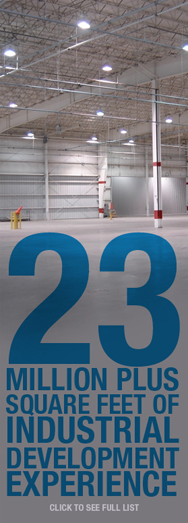2011 A Big Year For Industrial Real Estate ?
A great Industrial Article written by The Oakstone.
The heat is on in the industrial market. With improving positive absorption, very little new construction in the pipeline and the merger of two giants creating excitement, 2011 may very well be the year for this oft-overlooked corner of the real estate world.
In fact, sunnier days have already begun to make themselves evident. “There’s just a lot of positive signs in the market,” said Craig Meyer, Jones Lang LaSalle Inc. managing director & head of industrial real estate for the Americas. “It’s becoming much healthier than it was over the last couple of years.”
That assertion is borne out by the numbers: In fourth quarter 2010, 86 percent of the markets the company tracked had positive absorption. Moreover, when aggregating for all of 2010, the sector saw 60 percent positive absorption. Both of the major U.S. logistics markets—Philadelphia-Harrisburg and the Inland Empire in Southern California—
finished the year with more than 10 million square feet of positive absorption.
“We had the greatest absorption ever in the Inland Empire on buildings over 400,000 square feet by a substantial margin,” observed Lee & Associates senior vice president Paul Earnhart. “… We’ve run out of inventory … for the most
part on buildings over 500,000 square feet and are actually beginning to work on spec development transactions.”
With a 10.2 percent vacancy rate across the country, the industrial market is not yet entirely out of the woods.
However, Meyer believes that the sector has hit the bottom and is on its way up. “We are not yet seeing significant rental growth … we’re not quite there yet,” Meyer said. “So on the occupiers’ side, it really is an opportunity to take down significant space at (substantial) lows. It’s going to remain that way for most of 2011.”
In addition, noted Earnhart, despite continued difficulty with the economy and constrained availability of capital, particularly on the debt side, there is equity available, depending on the marketplace, as well as a significant number of
yield-driven pension funds and REITs seeking to buy specific types of product, such as industrial parks and larger buildings.
By far the biggest news in the industrial universe these days is the merger of ProLogis and AMB Property Corp. “I have mixed emotions,” Earnhart said of the merger. “They’re both exceptionally good companies and incredibly good people. We kind of hate seeing them merge because we’ve got one big company to do business with rather than two
companies to do business with.”
Manufacturing improvements are also impacting the sector, noted Jim Dieter, the head of the industrial practice at Cushman & Wakefield Inc. Such improvements portend well, he said, adding that they have been taking place
for the last 14 to 15 months.
“Manufacturing output has been a very, very positive trend in the U.S., and I can tell you that is one of the absolute key fundamentals to having a healthy industrial marketplace and a soon-to-be-healthy economy,” he said. “When
our manufacturing across the country keeps improving in its output, that means those products get transported. That means those products find themselves in warehouses and distribution centers. That means those products get put on rail lines. And so when you talk about the lifecycle of the industrial practice, manufacturing is right there as one of the major components.”
During the past year, he said, imports and exports in North America have increased well over 30 percent, resulting in very active port markets poised for growth throughout 2011 and 2012. Dieter also asserted that the growth of exports over the past two years is an indication of the U.S. economy expanding, and that demand for U.S. products means retail has shown positive growth as well.
“When imports are up and those products come across the oceans, they head for our distribution buildings to be warehoused and distributed out to the final destination, so that means the demand of our vacant industrial buildings around the country should show positive absorption over the next year or so,” he said. Already, he noted, most of the company’s offices are reporting increased tenant activity and absorption, with stabilizing rents.
“That’s a very good positive. I’m not going to go out on a limb and say rents are increasing, but they’re stabilizing. Vacancy rates have (also) leveled off.”
With very little new construction to speak of, Dieter said, the marketplace will be able to more efficiently absorb vacancies. With cap rates dropping as well, he believes there is good news on the horizon.
He also predicted that as transportation and energy costs continue to rise, an increasing number of companies will continue to work on their supply-chain efficiencies, whether the problem is size, location or general structure.
“What that means to the industrial market is that will increase overall activity,” he said. (credit a, landa,cpe)
Click Here to Read the entire article.

